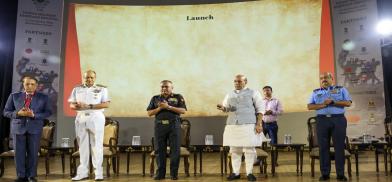China's growing tentacles in South Asia: How India is drawing inspiration from its ancient treatise to strategise national security
On October 21, 2023, India launched ‘Project Udhbav’ during the inauguration of the Indian Military Heritage Festival to synthesize ancient wisdom with contemporary military practices, forging a unique and holistic approach to address modern security challenges. It is tempting to draw a correspondence between India’s and China’s initiatives just 17 days apart.

India’s diplomatic relations with China are circumscribed by China’s territorial claims along shared borders, with military deployments leading to confrontation or conflict. However, relative war-fighting capability apart, China has economic and technological advantage over India, and this asymmetry is increased due to India’s heavy reliance on Chinese imports. [Ref.1]
The asymmetry is further accentuated by China’s aggressively successful diplomacy on economic, political and military fronts, with all of India’s smaller neighbours. [Ref.1] Thus, India is not in equilibrium with China, inasmuch as strategic diplomacy is concerned.
Apart from maintaining focus on China, in an increasingly complex world, India needs to urgently address and refine its strategic security concepts and governance practices. It is perhaps with this background, that Government of India has launched “Project Udbhav”.
Launch of Project Udbhav
On 21 October 2023, Defence Minister Rajnath Singh launched ‘Project Udbhav’ during the inauguration of the Indian Military Heritage Festival, in the presence of General Manoj Pande, Chief of the Army Staff; Air Chief Marshal VR Chaudhari, Chief of Air Staff; Vice Admiral SJ Singh, Vice Chief of Naval Staff; Lieutenant General JP Mathew, Chief of Integrated Defence Staff; Major General BK Sharma (Retd), DG United Services Institution of India, and other dignitaries.
The objective of Project Udbhav is to synthesize ancient wisdom with contemporary military practices, forging a unique and holistic approach to address modern security challenges. It is a “visionary initiative” by the Indian Army, that seeks “to integrate age-old wisdom with contemporary military pedagogy”. [Ref.2]
The Army published “Paramparik Bhartiya Darshan: Ranniti aur Netritva ke Shashwat Niyam” (Traditional Indian Philosophy: Eternal Rules of Warfare and Leadership), and is encouraging all ranks to read this book. [Ref.3]
Literature like Chanakya's Arthashastra underscores the importance of strategic partnerships, alliances and diplomacy, aligning with modern military practices such as international cooperation and soft power projection. Chanakya’s teachings on statecraft and warfare are studied by various institutions the world over. Similarly, the wisdom of Thirukkural, the classical Tamil text authored by Thiruvalluvar, the Tamil philosopher, advocates ethical conduct in all endeavours, including warfare. The Army holds that this aligns with modern military codes of ethics of just war and principles of Geneva Convention.
There are several learned treatises on statecraft in India’s 5,000-years of cultural heritage. However, Government of India and the Indian Army have presently focussed on Arthashastra. Indeed, a figure of Chanakya features prominently in a painting titled “Karam Kshetra – Field of Deeds”, installed in the office of the Army chief. The painting portrays the Army as “guardian of Dharma, fighting not merely as a defender of the nation but to uphold justice and protect the nation’s values”, with “the strategic and philosophical wisdom of Chanakya”. [Ref.4]
Arthashastra lessons in statecraft
Arthashastra is a respected treatise on statecraft, politics, economics, governance, and military strategy. It was written by Chanakya – also known as Kautilya – in the 4th century BCE. Arthashastra is sanctified as an upaveda, along with Ayurveda, Dhanurveda, Gandharvaveda and Shilpashastra.
Arthashastra’s principles and precepts have guided rulers (using the word “king” to mean “raja”) of small and large kingdoms or states in India since ancient times. A state was expected to have seven components (‘saptanga’) – king, council of ministers, capital city, its own territory, treasury, army, and foreign ally. The survival of a state required that its king was instructed in statecraft, and developed personal expertise in hand to hand combat.
Arthashastra is a prescriptive guide to a king on how to protect his state and increase his wealth by acquiring other kingdoms. [Ref.5] The assumption that the king of a neighbouring kingdom will also protect his own kingdom and try to increase his own wealth, and is therefore a potential enemy, is the in-built realism of Arthashastra. Recognizing that competition between adjacent states is a given, Arthashastra also mandates effective governance through fair and just management of the business of the state, to complement military strength.
To protect and promote the interests of the state, Arthashastra sanctions the use of four upaya-s or tools. These are sama (conciliation by negotiation), dama (gifts or inducements), danda (coercion, force or punishment), and bheda (creating dissension).
Chanakya distinguishes six major approaches to foreign policy. [Ref.6] The first, is a policy of maintaining peace with another state, based on a treaty detailing the terms and conditions. The second, is the policy of hostility, which should be followed if one is stronger than the enemy. The third, is one of inaction, which is most suitable when states are of equal strength. The fourth is outright invasion, but this policy is recommended for the very strong. For the very weak, a fifth approach is prescribed, namely, seeking shelter with another king, and waiting for better days. The sixth approach recommends a policy of peace with one king/state, while maintaining hostility towards another; such a dual policy is possible if help is available from another state to fight the enemy.
It is fair to assume that the Hindu rulers of states in India up to the 9th Century considered Arthashastra as their guide for statecraft, to increase their own wealth and power. This resulted in political boundaries shifting, due to the battles and wars among and between kings, right across the length and breadth of the subcontinent.
How Hindu disunity cost India
When Mahmud of Ghazni launched 17 raids into India between 1000 CE and 1027 CE, to plunder its fabled wealth, especially from its temples, he was staunchly opposed by Rajput kings. Mahmud raided as far east as Kannauj (present day Uttar Pradesh), but his raids were mainly in present day Punjab (both India & Pakistan) and Gujarat, where notably he sacked the sacred Somnath temple.
Mahmud was successful, because even after multiple raids, the Hindu kings remained divided among themselves, and failed to pool their military strengths. Worse, news of Mahmud’s victories over divided resistance from Hindu kings enthused Turk, Afghan and other muslim warlords, to make deeper incursions into India.
Some raiders chose to remain in India and succeeded in establishing their dynasties, because of fragmented opposition from Hindu kings. The Muslim raiders or kings fought among themselves for the loot – sometimes with help from one or more still mutually antagonistic Hindu kings – and political borders changed along with changing dynasties. This changing political situation culminated with the establishment of the Mughal empire.
Hindu rulers did of course win many battles against Muslim armies. However, the victories were not capitalised by other Hindu rulers who failed to forge long-term unity among themselves. Also, the size of the armies of Hindu rulers was limited by caste considerations – arming and training “shudras” and “untouchable out-castes” would have provided much larger fighting forces and also created internal unity of purpose.
Later, European seafaring nations established coastal trading posts in India with the consent of local or more distant kings. For example, in 1639, the English obtained a firmaan for land and trading rights at Madras, from Damerla Venkatadri Nayak, ruling at Chandragiri under the Hindu Vijayanagar kingdom. [Ref.7]
Using guile, bribery, etc., and making alliances as occasion demanded (Chanakya’s “kutayuddha”), coupled with use of trained and disciplined military forces, which included Indian men from all castes and out-castes, the English East India Company systematically defeated Hindu and Muslim rulers. Over decades, it established unitary control over most of India. The English monarch assumed ownership over the whole Indian subcontinent starting in 1858, by incorporating it as a colony of the British Empire. The states of many Hindu and Muslim rulers survived politically as “princely states” under British suzerainty. The Indian rulers – perhaps unknowingly – were obliged to adopt Chanakya’s fifth approach of foreign policy mentioned above.
The Muslim invaders and the British established their rules in India in a geopolitical flux spanning ten centuries. What is both interesting and significant is that they effectively – although certainly unknowingly – used Arthashastra’s four upaya-s to prosecute “kutayuddha”, with success. This may be seen as proof of the timeless applicability of the principles and precepts of Arthashastra, which inspire today’s Project Udbhav.
Realpolitik in modern times
Arthashastra considered that neighbouring kingdoms were natural enemies and neighbours beyond neighbours were natural allies. Thus, Arthashastra’s statecraft focused on the affairs of the treasury, the readiness of the army, and foreign policy. Apart from the imperative of maintaining military might against neighbours, Arthashastra also required a king to maintain a stable and wealthy state, by fair and just management of the business of the state. [Ref.5] All this called for informed statecraft, appropriately using the four upaya-s or tools of Arthashastra.
To protect and promote the national security interests of the state, Arthashastra statecraft upaya-s can be interpreted as realpolitik. In modern times, it is a combination of diplomatic negotiations and international cooperation, inducements through economic/financial aid and soft-power projection, coercion by the threat or use of force, and using intelligence and cyber power to create social or economic/financial disruption in a foreign state.
The complexity of the contemporary international community is because of the multiple cross-sector linkages. The term “national security” thus assumes an enlarged meaning. Effective statecraft begins with clearly defined national security policy to protect India’s economic, political and territorial sovereignty with respect to near and distant neighbours. This should guide India’s foreign policy. Would Arthashastra’s six approaches to guide foreign policy be applicable in the modern world?
Conventional wisdom is that the security of a state in relation to its immediate and distant neighbourhoods, cannot be effective without the domestic “firm base” of a healthy, secure, cohesive society, in a conducive economic and political environment. Only fair and just governance practices which promote fraternity among people, and peace and harmony in society, can build such a firm base. This is in keeping with Arthashastra’s mandate that the good and welfare of people should be at the core of statecraft. Are India’s governance practices working towards creating a stable and wealthy state?
Societal discontent and unrest, and militancy and extremism within India, are not recent. A study conducted in 2006, at the instance of the Planning Commission suggests, among other things, that unrest resulting in extremist methods and effort to resolve issues through violent means as a challenge to state authority is in response to accumulation of unresolved social and economic issues for long durations. [Ref.8] Social and economic issues remaining unresolved for long periods are due to nothing other than governance shortcomings and failures at state and central levels.
This continues even at present, and there are abundant examples. Notwithstanding government claims that militancy and extremism are at an all-time low, situations like societal unrest in Manipur since May 2023, continuing due to governance shortcomings, can only weaken the unity and integrity of the nation, and reduce India’s diplomatic heft in foreign affairs.
Managing multi-sectoral vulnerability
China presents a credible threat to India’s economic, political and territorial sovereignty. As much as shared land borders (3,488-km of LAC) are concerned, China has stepped-up military, economic and diplomatic pressures on India. A similar situation exists in the Bay of Bengal, North Indian Ocean and Arabian Sea. India is effectively encircled by China and states under China’s influence or control. [Ref.1]
This threat can be addressed and met, primarily by a combination of credible military power and strategic diplomacy.
In April 2024, (then) Indian Army chief General Manoj Pande said the Army is shaping "hard power" capabilities through self-reliance in the defence manufacturing sector to reduce or eliminate material and technological dependence upon foreign sources. [Ref.9] He stressed on critical technologies. This obviously also applies to the Air Force and Navy.
Modern militaries are concerned with warfare spanning land, ocean surface and submarine, air and space, and information-cyber-robotics. Effective engagement in these dimensions of warfare can be effective only with at least near-parity, especially in the critical technologies connected with information-cyber-robotics. China possesses advanced offensive cyber capability vis-a-vis India. India’s vulnerability in the military sector, was most recently exposed by China hacking into critical software products used by Indian manufacturers of drones and UCAVs. [Ref.10]
Wars are not fought only between militaries; the whole nation goes to war. In the emerging IT-IW battlefield of tomorrow, defence goes beyond military capability, and involves critical sectors of the economy that underpin military capability. The operation and planning of every sector of the Indian economy is digitised, using computers and connected hardware and software, and ‘cloud’ facilities. It is reality that most critical equipment, and hardware and software components, are purchased from international vendors. Foreign nations (especially China) installing hardware backdoors or clandestine software access to databases [Ref.11] are real-time vulnerabilities, which compromise national security.
Cyber attacks on the national economy will have severe consequences on military capability and effectiveness. For example, a cyber attack disrupting railway operations computer systems, will at least temporarily halt railway movements to shift military reserves, besides causing serious financial and economic loss. Similar attacks on electricity power grids; telecommunications grids; police and internal security; banks, stock markets and trade-and-finance; petroleum sector; civil aviation; governance nodes; water supply; etc., will impinge on public order, safety and health, and paralyse governance. A cyber strike on multiple sectors can cripple the economy and create public chaos.
National security strategy to protect sovereignty, includes managing the vulnerabilities in such scenarios.
China’s and India’s initiatives
On October 4-5, 2023, China convened its “3rd China-Tibet ‘Rim of the Himalayas’ International Cooperation Forum for International Cooperation” in Tibet’s Nyingchi. [Ref.12] The Forum was attended by senior officials from Pakistan, Nepal, Bhutan, and Sri Lanka, among others. On November 4, 2023, the 2023 Annual Conference of the China South Asia Society and the Intersection and Integration of Regional Country Studies and Frontier Studies academic seminar were held in Lhasa. This was meant for China to have access to South Asia in terms of policies, facilities, trade, and capital. It confirms that China is focussing on growing its economic, political and military influence [Ref.12] in South Asia.
On October 21, 2023, India launched ‘Project Udhbav’ during the inauguration of the Indian Military Heritage Festival to synthesize ancient wisdom with contemporary military practices, forging a unique and holistic approach to address modern security challenges. It is tempting to draw a correspondence between India’s and China’s initiatives just 17 days apart. However, China’s aim was to increase its economic, political and military influence in South Asia, while India’s aim was limited to addressing modern security challenges.
The road ahead
Project Udbhav is an Army initiative, endorsed by Ministry of Defence. However, for essential technology-based military jointness, and effective action on the emerging cyber-battlefield, the Navy and Air Force, and the Defence Cyber Agency, need to be included. Further, only by including other key ministries like External Affairs, Home, Finance, Science & Technology, and Electronics & Information Technology, can a wealthy and stable state, as mandated by Arthashastra, be created.
India has projected itself as among the top-runners on the world stage and seeks a permanent seat in the UN Security Council. [Ref.13] For this to fructify, India’s own national security needs to be systematically strategised. This will provide clarity of foreign policy and strategic national security based on realpolitik, and direct constitution-based governance practices by state and central governments for the unity and integrity of India’s federal union. It will also add strength to India’s aspirations to the global high-table.
References hyperlinked in the text
1. S.G.Vombatkere; “India In a challenging neighbourhood: Need to reach non-confrontational equilibrium with China“; <https://www.southasiamonitor.org/spotlight/india-challenging-neighbourhood-need-reach-non-confrontational-equilibrium-china>; South Asia Monitor; January 27, 2025.
2. “Project Udbhav: A collaborative initiative by Indian Army and United Services Institution of India”; <https://pib.gov.in/PressReleaseIframePage.aspx?PRID=1969684>; Press Information Bureau, New Delhi; October 21, 2023.
3. Rahul Singh; “Army seeks statecraft, military lessons from ancient Indian texts”; <https://www.hindustantimes.com/india-news/arthashastra-thiruvalluvar-s-kural-part-of-army-s-deep-dive-into-wisdom-of-ages-101696002046490.html>; Hindustan Times; September 30, 2023.
4. Dinakar Peri; “Painting on 1971 surrender replaced in Army Chief’s lounge, veterans miffed”; <https://www.thehindu.com/news/national/painting-on-1971-surrender-replaced-in-army-chiefs-lounge-veterans-miffed/article68982893.ece>; The Hindu; December 14, 2024.
5. Rhitwique Dutta, Kaushik Dutta, Hemeswari Bhuyan ; “Kautilya’s Arthashastra and Indian Military Reforms”; <https://www.researchgate.net/profile/Hemeswari-Bhuyan/publication/372677827_Kautilya%27s_Arthashastra_and_Indian_Military_Reforms/links/64c288b70fae1319bfbc280a/Kautilyas-Arthashastra-and-Indian-Military-Reforms.pdf?origin=scientificContributions>; Research Gate; ISSN: 0048-2706 (Print), ISSN: 2227-9199 (Online); January 2023.
6. Col Harjeet Singh; “The Kautilya Arthaśāstra: A Military Perspective”; <https://www.claws.in/static/MP38_The-Kautilya-Arthasastra-A-Military-Perspective.pdf>; Maneckshaw paper, No.38 (2013); Centre for Land Warfare Studies, RPSO Complex, Parade Road, Delhi Cantt, New Delhi 110010.
7. S.G.Vombatkere; “A Sell-out to the Powerful: History Repeats itself”; Mainstream Weekly, New Delhi, Vol XLVII No 35, August 15, 2009, p.51. At <https://lists-archive.sarai.net/reader-list/2009-August/022120.html>.
8. “People’s discontent and system failure”; Report of the Expert Group on Development Issues to Deal with the Causes of Discontent, Unrest and Extremism, set up by the Planning Commission, in May 2006; <https://www.mainstreamweekly.net/article749.html>; Mainstream Weekly, New Delhi; Vol XLVI No 25; June 8, 2008.
9. Rahul Singh; “‘India’s security can’t be outsourced’: Army chief stresses on self-reliance”; <https://www.hindustantimes.com/india-news/indias-security-can-t-be-outsourced-army-chief-stresses-on-selfreliance-101713882380648.html>; Hindustan Times; April 23, 2024.
10. Pradip R. Sagar; “Chinese threat in Indian drones”; <https://www.indiatoday.in/magazine/defence/story/20250210-chinese-threat-in-indian-drones-2672839-2025-01-31>; India Today; February 10, 2025.
11. S.G.Vombatkere; “Cyber Security: Going Beyond Data Protection”; <https://countercurrents.org/2018/01/24/cyber-security-going-beyond-data-protection/>; Countercurrents.org; January 24, 2018.
12. Jayadev Ranade; “Tibet, the fulcrum of China’s Strategic Policy in the Himalayas”; <https://www.vifindia.org/article/2023/december/05/tibet-the-fulcrum-of-china-s-strategic-policy-in-the-himalayas>; Vivekananda International Foundation; December 5, 2023.
13. “India’s Permanent position in UNSC”; <https://www.mea.gov.in/rajya-sabha.htm?dtl/38630/QUESTION_NO_38_INDIAS_PERMANENT_POSITION_IN_UNSC>; “RAJYA SABHA STARRED QUESTION NO. 38, ANSWERED ON 28.11.2024”; Media Centre, Ministry of External Affairs, Government of India; November 28, 2024.
~~~~~~~~~~~~~~~~~~~~~~~~~~~~~~~~~~~~~
(The author is an Indian Army veteran settled in Mysuru, Karnataka. He has over 900 published articles and over 80 published papers in developmental and strategic affairs. Views expressed are personal. He can be contacted at sg9kere@live.com )











Post a Comment